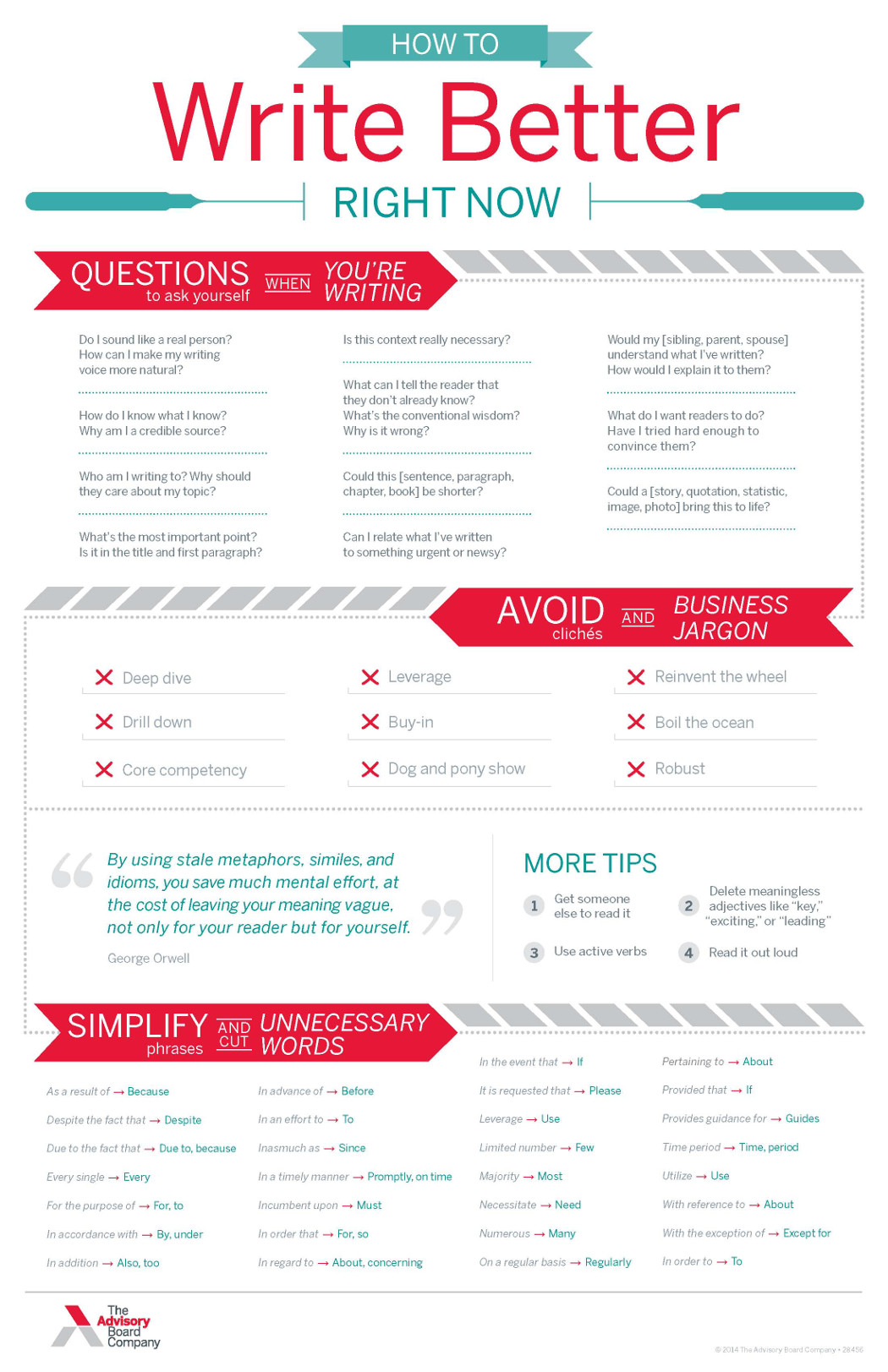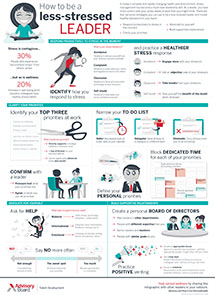Auto logout in seconds.
Continue LogoutRead Advisory Board's take: How to avoid sounding robotic when speaking in public
For many, public speaking is a fate worse than death, but it can be a lot less overwhelming with a bit of preparation, Adam Bryant, a managing director at Merryck & Co., writes in a New York Times guide. Bryant, an 18-year veteran at the Times who's spoken to over 525 chief executives about how they lead, offers five tips on how to be a better public speaker.
1. Start at the beginning
Being well-prepared for your presentation is key, Bryant writes, and it's important to keep things simple. Marcus Ryu, CEO of Guidewire Software, shared his "Einstein Theory of Communication" in an interview with Bryant. Ryu explains, "You could have a room full of Einsteins, but if there are 200 or 300 of them, then you still have to talk to them like they're just average people." As the audience grows, "your message has to get simpler and simpler, and the bullet-point list has to be shorter and shorter," Ryu said.
To do this, Bryant writes that it's important to ask yourself, "What is the central question you are asking and answering?" You should craft your presentation around that central question and "use bullet points to crystallize your subthemes," Bryant writes.
It's also helpful to get an editor, Bryant writes. Find someone whose judgment you trust and who you feel like you can test your presentation with to make sure the takeaways are clear and the key insight is apparent.
2. Build up to it
It takes time and practice to get to a point where you feel natural and comfortable with public speaking, so work up to it, Bryant writes.
If you're new to public speaking, the first thing you should do it write out your entire speech. Your speech should include conversational phrases and sentence structures. "[M]ake sure your talk sounds as natural as if you were speaking at a dinner party," Bryant writes.
After that, practice your speech as much as you can, both alone and in front of others. Bryant suggests taking one piece of your speech and trying to weave it into a meeting at work or a gathering of friends to help get comfortable with the material.
Eventually, you'll reach a point where you can just use bullet points or cue cards to remind yourself of your main talking points. And don't worry if you forget a point in your presentation, Bryant writes. "Nobody knows what you forget to say. If you didn't mention something, no big deal."
No matter how comfortable you get with public speaking, you'll likely always be nervous. "The key is channeling and focusing that nervousness in a positive way," Bryant writes. "Remember this clever saying: 'It's okay to have butterflies; just get them to fly in formation.'"
3. Turn up the energy
If people will remember anything about your presentation, it will be your energy, Bryant writes. "[I]f you inspire people a bit, they will remember how you made them feel," Bryant writes. "You need to turn up the dial on yourself to 11," he writes, "Not in terms of how loud you speak, but in terms of your personality."
While this might feel like a lot of energy, this is the level you need to be at to make an impression. "Even though you may feel like you're a bit over the top, it will feel like a 7 to the audience," Bryant says.
Also, never apologize before your presentation, Bryant writes. Sometimes, people will apologize for some part of their talk to lower expectations. "Resist the temptation," he writes. "Step up and own it."
4. Connect with your audience
For many public speakers, it can be hard to break through the "invisible wall between you and your audience," Bryant writes. But the secret to doing so is simple, Bryant writes.
The first step: Thank people for their time and the chance to speak.
Then, find a way to make a personal connection with your audience. "It doesn't take a lot, and the connection can take many forms, like a shared interest or experience," Bryant writes. "But put in the effort and time to find something."
For example, Bryant writes, you can pose a question to your audience, such as, "Show of hands, how many people have …?" You'll then want to make eye contact with as many people who have their hands raised as possible.
And if your audience doesn't seem to click with you, just remember it's not always your fault, Bryant writes, and you shouldn't take it personally. "It might be the time of day, the temperature in the room, what they served for lunch—plenty of things that aren't about you."
5. Be prepared for anything
There's always a chance things can go wrong during your talk, so it's important to be proactive, Bryant writes. Show up early to the presentation, meet the tech people, shake their hands, and find out what your AV set-up is going to be.
If possible, it's also good to use your own computer, since it's the one you're most comfortable with. And always arrive prepared with any of the technology you might need, Bryant writes. Bring your own adapters, chargers, clicker, and anything else that the AV staff might not have.
Finally, look in a mirror before you go on. Make sure everything is in place, that there aren't any stray threads on your clothes, or anything in your teeth.
"You've earned the opportunity to be invited to come share your thoughts," Bryant writes. "So be your best self, create some energy in the room (and maybe a bit of inspiration) and people will remember you long after you've left the stage" (Bryant, New York Times, January 2019).
Advisory Board's take

Craig Pirner, Managing Director, Talent Development
While a fear of public speaking is understandable, leaving it unaddressed can be professionally debilitating and organizationally harmful—stopping you from sharing your ideas with others (and thus spreading your influence) and preventing your organization from benefiting from the ideas you might communicate.
The faculty of Advisory Board’s Talent Development group has been speaking publicly and helping others do the same for many years. After reading Adam Bryant's five excellent tips above, I wanted to chime in with my answer to a question I'm often asked: How do I avoid sounding like a robot (or Charlie Brown's teacher) when I speak?
The answer lies in vocal variety. As you consider where to use variance to enhance your message, think through the following issues:
1. Pitch. Consider how you can use the full range of your voice. For instance, a lower pitch often conveys seriousness of purpose, while a higher pitch often underscores humor.
2. Volume. Aim to always be heard, but do vary your volume as you present. Decreasing volume can often be as effective in getting attention as raising volume. If you raise volume, be sure to come back down (otherwise you'll be shouting by the end of the presentation!) Listen carefully for a tendency to trail off in volume as you speak. This is annoying to listeners, and most often, it's the result of not using your diaphragm and thus losing your breath by the end of the thought.
3. Tempo. Consider carefully how quickly you are speaking. Avoid relentless use of the extremes: Speaking too quickly makes your audience tired (because they have to work extra hard to keep up with you), while speaking too slowly makes your audience bored (because they have to work hard to stay energized). In general, aim for a conversational pace, and then use hastened or slowed tempo to emphasize a point.
4. Tone. This is the most nuanced of the vocal variety strategies; tone is about the emotional content of the voice. Consider the extent to which your tone matches your message. For example, if you're sharing a difficult patient story, a dispassionate tone may conflict with the emotional message. If you're sharing the latest scientific evidence, an overly emotional tone may distract the audience from the message itself.
While it is important to seek variation, it must be grounded in your message. Vary your pitch, volume, tempo, and tone because you believe it enhances what you are there to communicate. Variation for the sake of variation alone is maddening to the audience—it feels like a performance.
To discover five other tips I've learned over years of public speaking, make sure to read my six-part plan to becoming a better public speaker. Then, download my infographic for four keys to becoming a less-stressed leader.
Here are 4 ways to be a less-stressed leader
Stress is endemic in today’s health care workforce, but the good news is that leaders have much more control over their stress levels at work than they might think. The most effective leaders take steps to proactively keep their own stress in check—while modeling healthy habits for their teams.
Use this infographic to review effective stress management strategies that can help you become a less-stressed leader.
Don't miss out on the latest Advisory Board insights
Create your free account to access 1 resource, including the latest research and webinars.
Want access without creating an account?
You have 1 free members-only resource remaining this month.
1 free members-only resources remaining
1 free members-only resources remaining
You've reached your limit of free insights
Become a member to access all of Advisory Board's resources, events, and experts
Never miss out on the latest innovative health care content tailored to you.
Benefits include:
You've reached your limit of free insights
Become a member to access all of Advisory Board's resources, events, and experts
Never miss out on the latest innovative health care content tailored to you.
Benefits include:
This content is available through your Curated Research partnership with Advisory Board. Click on ‘view this resource’ to read the full piece
Email ask@advisory.com to learn more
Click on ‘Become a Member’ to learn about the benefits of a Full-Access partnership with Advisory Board
Never miss out on the latest innovative health care content tailored to you.
Benefits Include:
This is for members only. Learn more.
Click on ‘Become a Member’ to learn about the benefits of a Full-Access partnership with Advisory Board
Never miss out on the latest innovative health care content tailored to you.


